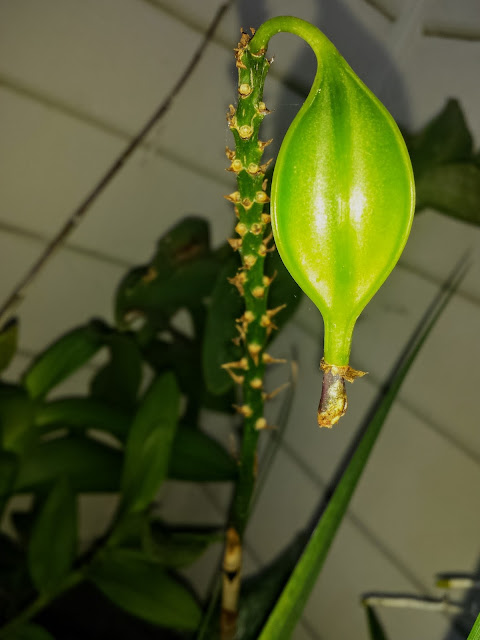I started composing a post on the topic but it quickly grew into
a blog entry. Let's see how well I can get to the heart of the matter.
My
Epc Cerina 'Nadia' has a big seed pod on it...

Hopefully it's the result of pollen from this cross by
SVO...
Epi (Pacific Eclipse x Pacific Canary) ‘Yellow Sun’ x Epi magnoliae
Would you be happy if I split the seeds with you? Or would you prefer to
shell out $50 bucks to buy Cerina on eBay? Would you more highly prefer the seeds if you knew for a fact that they could
germinate without fungus/flasking?
Let's imagine that I do split the seeds with you. We won't have the same exact germination rate for various reasons. For example, our temps will be different.
We'll keep it simple and say that, out of 1000s and 1000s of seeds, we each end up with 50 seedlings. The question is, how well adapted are the seedlings to our conditions? We could find out by exchanging half of our seedlings with each other. In your conditions, the better that your seedlings did compared to my seedlings, the better adapted that your seedlings are to your conditions.
So the more adaptable the cross is, the more beneficial it is to grow it from seed. You are more likely to end up with an orchid that does much better in your conditions.
Maybe some numbers will help?
Say that the optimal temp for Cerina is 85F. You grow your orchids inside your house, where the temp is 78F. If the optimal temp for all the seeds/seedlings of Cerina x SVO's orchid is also 85F, then as far as temps are concerned there'd be no benefit to growing it from seed. But what if the optimal temp for the cross ranges from 86F to 84F? For some seeds/seedlings the optimal temp is 86F, for others it's 85F and for others it's 84F. In this case there would be a very small benefit to growing it from seed. The larger the range of optimal temps, the larger the benefit.
Growing the cross from seed is like casting a net. The more adaptable the cross, the bigger the net, which means catching a better orchid.




























 Linear Mode
Linear Mode


